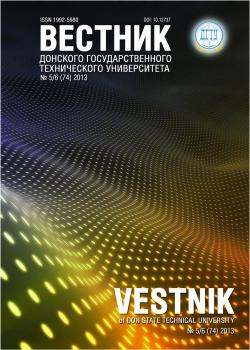When evaluating a thermal state of the cutting zone, there is a need to define the thermal flow capacity on the tool contact areas which are determined by the tension magnitude. A review of the native and foreign research on the tension evaluation under cutting with account for the mechanical behaviour of the process materials, as well as the temperature, strain degree and rate is offered. Specialists in noncutting shaping have obtained experimental dependences that could be also used in machining — when the strain degree and rate can be calculated by the cutting theory formulae. The tension in the shear area can be determined indirectly — using the energy balance equation for the cutting process based on the experimental data on the cutting force components and corresponding speeds. As for the heat calculations, at first, analytic dependences defined on the base of the energy balance equation under cutting are recommended for the shear stress evaluation. Secondly, the dependences including relative shift value for the stress analysis should be used.
cutting temperature, shear plane, shear strain, strain speed, shear stress.
Введение. Тепловое состояние твердосплавного режущего инструмента на форсированных режимах резания в конечном итоге определяет работоспособность инструмента, а также качество изделий и производительность процесса обработки. (В данном случае речь идёт об обработке материалов, относящихся к группе труднообрабатываемых: жаропрочные стали и сплавы, титановые сплавы, композиционные материалы и др.) Известные схемы расчёта температур в зоне резания [1—9] базируются на учёте тепловых потоков и температур, возникающих в зоне деформации и на контактных площадках инструмента. Для соответствующих вычислений необходимо знать касательные напряжения на передней (тш) задней (тзп) поверхностях инструмента и напряжение (т ) плоскости сдвига.
1. Reznikov, А. N. Teplofizika rezaniya. [Cutting thermophysics.] Moscow : Mashinostroyeniye, 1969. - 288 s. (in Russian).
2. Klimenko, S. A., ed. Obrabotka materialov lezviynym instrumentom. [Edge tool processing of materials.] Kiyev : ISM im. V. N. Bakulya NANU ; IPCz"ALKON" NANU, 2006, vol. 5, 316 p. (in Russian).
3. Kushner, V. S. Termomekhanicheskaya teoriya protsessa nepreryvnogo rezaniya plastichnykh materialov. [Thermomechanical theory of plastic materials continuous cut process.] Irkutsk : Izdatelstvo Irkutskogo universiteta, 1982,180 p. (in Russian).
4. Belousov, A. I., et al. Teplovyye yavleniya i obrabatyvayemost rezaniyem aviatsionnykh materialov. [Thermal effects and aircraft materials cutability.] Moscow : Mashinostroyeniye, 1968, 179 p. (in Russian).
5. Puchkin, V. N., et al. Vliyaniye temperatury pri obrabotke trudnoobrabatyvayemykh staley rezhushchey keramikoy. [Temperature effect under hard-to-cut steel ceramics machining.] Stanki i instrument, 2010, no. 5, pp. 24-27 (in Russian).
6. Loladze, T N. Iznos rezhushchego instrumenta. [Cutting tool wear.] Moscow : Mashinostroyeniye, 1958, 356 p. (in Russian).
7. Sklin, S. S. Metod podobiya pri rezanii materialov. [Similarity method under cutting.] Moscow : Mashinostroyeniye, 1979,152 p. (in Russian).
8. Vasin, S. A., et al. Rezaniye materialov. [Material cutting.] Moscow : Izdatelstvo MGTU im. N. E. Baumana, 2001, 447 p. (in Russian).
9. Ryzhkin, A. A., et al. Raschet temperatury zadney poverkhnosti rezhushchego instrumenta. [Temperature calculation of cutter end flank.] Problemy sinergetiki v tribologii, triboelektrokhimii, mate-rialovedenii i mekhatronike : materialy XI mezhdunar. nauch.-prakt. konf. [Synergetics problems in tri-bology, triboelectrochemistry, hylology, and mechatronics : Proc.XI Int. Sci.-Pract. Conf.] Novocherkassk, 2012, pp. 3-22 (in Russian).
10. Del, G. D. Opredeleniye napryazheniy v plasticheskoy oblasti po opredeleniyu tverdosti. [Stress calculation in plastic domain under hardness testing.] Moscow : Mashinostroyeniye, 1971, 199 p. (in Russian).
11. Poletika, M. F. Kontaktnyye nagruzki na rezhushchikh poverkhnostyakh instrumenta. [Bearing pressures on tool surfaces.] Moscow : Mashinostroyeniye, 1969,150 p. (in Russian).
12. Zorev, N. N. Voprosy mekhaniki protsessa rezaniya metallov. [Issues of metalcutting mechanics.] Moscow : Mashgiz, 1956, 368 p. (in Russian).
13. Rozenberg, A. M., Eremin, A. N. Elementy teorii protsessa rezaniya metallov. [Metalcutting process theory elements.] Sverdlovsk : Mashgiz, 1956, 319 p. (in Russian).
14. Wolf, A. M. Rezaniye metallov. [Metalcutting.] Leningrad : Mashinostroyeniye, 1973, 496 p. (in Russian).
15. Kushner, V. S., et al. Razvitiye teorii protsessa rezaniya zharoprochnykh splavov na osnove termomekhanicheskogo podkhoda. [Theory development of metalcutting process of hot-strength alloys based on thermomechanical approach.] Tekhnologiya mashinostroyeniya, 2005, no. 11, pp. 14-16 (in Russian).
16. Klushin, M. I. Rezaniye metallov. [Metalcutting.] Moscow : Mashgiz, 1958, 454 p. (in Russian).
17. Vorontsov, A. L, et al. Razrabotka novoy teorii rezaniya. [A new metalcutting theory development.] Vestnik mashinostroyeniya, 2008, no. 1, pp. 57-67(in Russian).
18. Storozhev, M. V., Popov, E. A. Teoriya obrabotki metallov davleniyem. [Metal forming theory.] Moscow : Mashinostroyeniye, 1977, 423 p. (in Russian).
19. Krokha, V. A. Uprochneniye metallov pri kholodnoy plasticheskoy deformatsii. [Metal hardening under cold flow.] Moscow : Mashinostroyeniye, 1980,157 p. (in Russian).
20. Johnson, W., Mellor, P. Teoriya plastichnosti dlya inzhenerov. [Engineering plasticity.] Moscow : Mashinostroyeniye, 1979, 567 p. (in Russian).
21. Polukhin, P. I., et al. Soprotivleniye plasticheskoy deformatsii metallov i splavov. [Metal and alloy plastic resistance.]. Moscow : Metallurgiya, 1983, 351 p. (in Russian).
22. Brovman, M. Y. Soprotivleniye deformatsii v protsessakh obrabotki davleniyem pri vysokikh temperaturakh. [Deformation stress under plastic working at high temperatures.] Tekhnologiya legkikh splavov, 1979, no. 8, pp. 26-30 (in Russian).
23. Tretyakov, A.V., et al. Mexanicheskie svojstva stalej i splavov pri plasticheskoj deformacii. [Mechanical properties of steel and alloys under plastic deformation.] Moscow : Mashinostroyeniye, 1971, 63 p. (in Russian).
24. Voronzov, A. L, et al. Razrabotka novoy teorii rezaniya. [A new cutting theory development.] Vestnik mashinostroyeniya, 2008, no. 2, pp. 56-64 (in Russian).
25. Gurevich, Y. L, et al. Rezhimy rezaniya trudnoobrabatyvayemykh materialov. [Cutting conditions for hard-to-machine materials.] Moscow : Mashinostroyeniye, 1976,176 p. (in Russian).
26. Dalskiy, A. M., ed., et al. Spravochnik tekhnologa-mashinostroitelya : v 2 t. [Handbook for a mechanic engineer : in 2 vol.] 5th revised and enlarged ed. Moscow : Mashinostroyeniye, 2003, vol. 2, 944 p. (in Russian).





